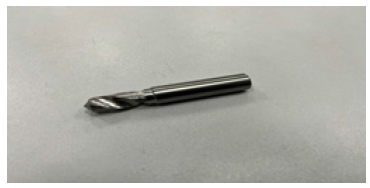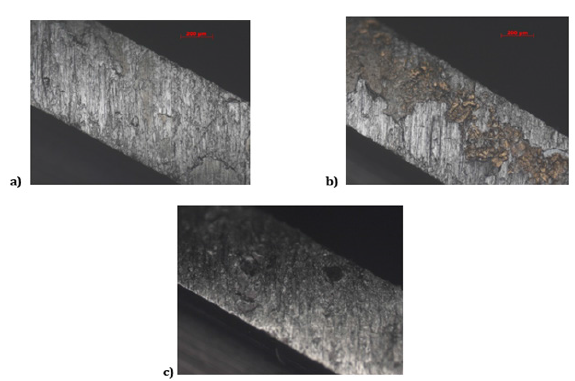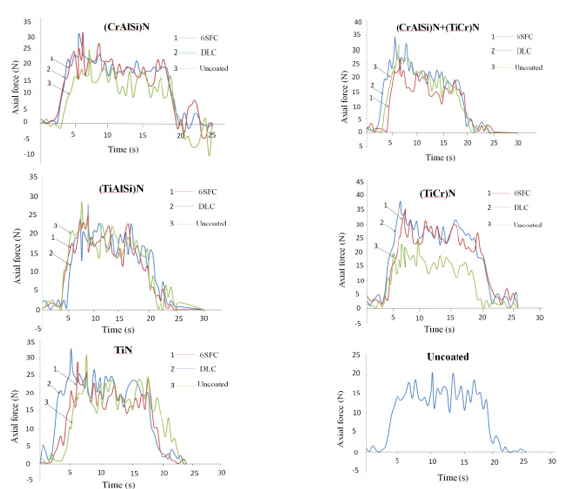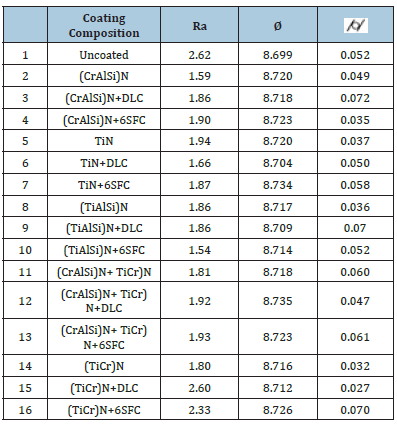- Submissions

Full Text
Research & Development in Material Science
The Effect of Antifriction Coatings on the Drilling Process of Titanium Alloy
Тhet Oo and Fedorov SV*
Moscow State University of Technology “STANKIN”, Russia
*Corresponding author: Fedorov SV, Moscow State University of Technology “STANKIN”, 1 Vadkovsky per., Moscow, 127055, Russia
Submission: December 16, 2022;Published: January 26, 2023

ISSN: 2576-8840 Volume 18 Issue 3
Abstract
The expansion of the metal leads to pressure on the tool when drilling titanium alloys due to their low thermal conductivity. At the same time, the strength of the heat source during shaping largely depends on the friction forces on the working surfaces of the tool, and the effectiveness of applying a nitride wear-resistant coating will largely depend on the ability to reduce frictional interaction on the contact pads. Additional antifriction coatings, which can be applied in various ways, can provide some help here. The paper investigates the effect of PVD DLC coating and epilaming technology on the cutting force and geometric characteristics of the resulting holes.
Keywords: Titanium alloy; Drilling; Anti-friction coatings
Introduction
Additional difficulties associated with the low thermal conductivity of the titanium alloy are among the issues that arise during the drilling process. Since the heat generated during the cutting process is distributed rather slowly throughout the workpiece, the expansion of the metal results in significant pressure on the tool. Chips actively stick to it, the coefficient of friction increases, and additional heat is released. The high temperature and its adverse distribution in the cutting tool significantly reduce the cutting time before exchange the tool.
Wear-resistant coatings are widely and quite successfully used. Furthermore, modern coatings can be considered wear-resistant complexes that are designed with the working conditions in mind. Three-to-five times the effect of increased durability in the machining of carbon steels has already become the norm. However, when machining titanium alloys, an increase in tool life by 50-70% can already be considered a success.
From classical works in the field of the theory of cutting materials, it is known that the force of a heat source during shaping largely depends on the friction forces on the working surfaces of the tool. Therefore, the effectiveness of their application will largely depend on the ability to reduce frictional interaction on the pads, of course, while maintaining thermal stability. Here, additional antifriction coatings can be helpful and can be applied in various ways [1].
Diamond-Like Carbon coatings (DLC) have clear advantages over nitride and oxide coatings in terms of providing a reduced coefficient of friction on the working surfaces of the tool. But it should be borne in mind that the use of DLC coatings for cutting tools in the processing of difficult-to-machine alloys is limited by their relatively low heat resistance. Nevertheless, modern DLC coatings remain underestimated, but they have certain prospects for increasing the cutting ability of a tool when cutting titanium alloys.
Another interesting way to reduce friction is by using epilamation technology, which is based on the use of surfactants in fluorocarbon volatile solvents. Such solutions are applied to the tool surface and, after evaporation, form a thin film up to 100 nm thick. Modern compositions are quite capable of working in the zone of sufficiently high temperatures.
New experimental results on the evaluation of the anti-friction coatings’ effect on the hole accuracy and surface roughness of the workpiece can be a step towards expanding the areas of their technological application and implementation based on new technical solutions.
Materials and Methods
A plate made of the high-strength titanium alloy VT18U with a thickness of 15mm was used as a workpiece. The chemical composition of the alloy is shown in Table 1.
Table 1:The composition of the alloy VT18U.

We tested a part of short series drills with a cutting length of 25mm and a diameter of 8.7mm (2φ=118о, ω=30о) made of KFM39 carbide with a Co content of 9% (Konrad micro drill, Germany) (Figure 1), which were coated with Platit π311+DLC installation nitride wear-resistant coatings with different content of chromium and titanium: TiN, (CrAlSi)N, (CrAlSi)N+(TiCr)N, (TiAlSi)N, (TiCr)N 4μm thick. Some of the drills were DLC coated by the CVD method in an acetylene atmosphere with the addition of 2μm thick tetramethyl silane. Part of the drills was subjected to the epilamation procedure in the boiling composition 6SFC-180-05 at a temperature of 55 °C for 40 minutes.
Figure 1:Drill.

Drilling was carried out on a KNUTH WF-1 milling machine (cutting mode: 2000rpm, feed rate: 53mm/min) using a Kistler dynamometer (Switzerland) with coolant. To measure the characteristics of the obtained holes (diameter, noncylindricity, roughness), a GLOBAL coordinate measuring machine (Italy) with a resolution of 1.7μm and a device for measuring roughness and profile parameters, the Hommel Tester T8000 (USA), were used. The cutting-edge rounding radius was controlled on a MicroCad lite instrument (GFM, Germany).
Results and Discussion
Due to the low thermal conductivity of titanium, when the workpiece is heated, the diameter of the hole being machined decreases slightly and the tool sticks. As a result, the ribbon suffers first of all, on which numerous lumps are formed. Depending on the composition of the coating, the sticking intensity varies. Figure 2 shows characteristic photographs.
Figure 2:Titanium deposits on the drill bit; a) original drill without treatment, b) TiN+DLC coating, c) (TiAlSi)+6SFC coating.

Measurement of cutting force shows a trend toward a slight increase on drills with coatings. The effect is especially noticeable for TiN and (TiAlSi)N coatings. The results of measuring the axial force are shown in Fig.3. At the same time, it should be noted that the radius of rounding of the cutting edge remained practically unchanged after coating, and its values varied within 8-11μm. It can be seen that the application of the antifriction component of the coating also affects the axial force. Moreover, for different coatings, this effect is different. For example, in the case of the (TiCr) N coating, the force increases significantly, whereas in the case of (CrAlSi)N+ TiCr)N+6SFC, it has the lowest value, comparable to the value of the force on the original sample (Figure 3).
Figure 3:Values of the axial component of the cutting force.

It should be noted that despite the decrease in the friction coefficient on the drill surface from 0.4-0.7 in the initial state and after the application of nitride coatings to 0.15-0.3 after the application of the antifriction component of the coating, the amount of adhering titanium did not fundamentally change.
The formation of build-up leads to the formation of a negative rear angle on the drill ribbon, and the tool, at least in its cylindrical part, begins to work like a mandrel. This leads to a significant drop in surface roughness in the machined hole and an increase in the hole diameter (Table 2). But this is also the reason for the increase in axial force.
Table 2:Hole parameters.

The unstable operation of the drill, associated with the appearance of vibrations, affects the non-cylindricality of the holes. But the deviation is rather random in nature, and it is difficult to single out any dependence here.
Conclusion
In this study, the influence of the antifriction component of the wear-resistant coating on the dimensional tolerances and roughness of the resulting hole and the axial cutting force when drilling the VT18U alloy was studied.
Five nitride coatings with different contents of Cr, Ti, and Al were studied. Layers of DLC and epilam 6SFC-180-05 were used as an antifriction component.
There is a tendency to increase the axial force when working with drills with wear-resistant coatings. This may be due to the intense sticking of titanium to the drill bit, which leads to deformation of the surface of the hole being machined and an increase in its diameter to 0.03mm.
The behavior of antifriction coatings under these conditions is recognized as ambiguous, but nevertheless, it should be noted that the use of coatings based on (TiAlSi)N with both antifriction components gave the best result. The research was carried out at the expense of the grant of the Russian Science Foundation No. 22- 19-00694.
References
© 2023 Fedorov SV. This is an open access article distributed under the terms of the Creative Commons Attribution License , which permits unrestricted use, distribution, and build upon your work non-commercially.
 a Creative Commons Attribution 4.0 International License. Based on a work at www.crimsonpublishers.com.
Best viewed in
a Creative Commons Attribution 4.0 International License. Based on a work at www.crimsonpublishers.com.
Best viewed in 







.jpg)






























 Editorial Board Registrations
Editorial Board Registrations Submit your Article
Submit your Article Refer a Friend
Refer a Friend Advertise With Us
Advertise With Us
.jpg)






.jpg)














.bmp)
.jpg)
.png)
.jpg)










.jpg)






.png)

.png)



.png)






